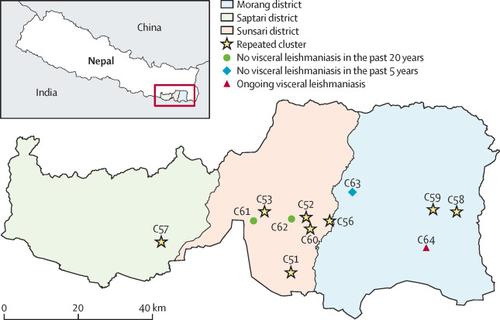The Lancet Global Health ( IF 19.9 ) Pub Date : 2020-01-22 , DOI: 10.1016/s2214-109x(19)30536-4 Kristien Cloots 1 , Surendra Uranw 2 , Bart Ostyn 1 , Narayan Raj Bhattarai 2 , Epke Le Rutte 3 , Basudha Khanal 2 , Albert Picado 4 , François Chappuis 5 , Epco Hasker 1 , Prahlad Karki 2 , Suman Rijal 6 , Marleen Boelaert 1

|
Background
Nepal launched a visceral leishmaniasis (also known as kala-azar) elimination initiative in 2005. We primarily aimed to assess whether transmission of Leishmania donovani had decreased since the launch of the initiative. We also assessed the validity of the direct agglutination test (DAT) as a marker of infection, in view of future surveillance systems.
Methods
We did a repeat survey in a population aged 2 years and older for whom baseline serological data were available from 2006. Data were from three districts in the eastern region of Nepal. The primary outcome of interest was prevalent infection with L donovani as measured with DAT (cutoff value ≥1:3200). We compared age group-specific and cluster-specific seroprevalences in 2016 with those in 2006, using χ2 tests, with a specific focus on the comparison of seroprevalences in children born between 1996 and 2005, and those born between 2006 and 2015. To estimate the overall adjusted risk ratio for being seropositive in 2016 compared with 2006, we fitted a Poisson model controlling for age, sex, and cluster.
Findings
Between Oct 17, 2016, and Dec 26, 2016, we assessed 6609 individuals. DAT prevalence in children younger than 10 years was 4·1% (95% CI 3·2–5·4) in 2006 versus 0·5% (0·1–1·7) in 2016 (p<0·0001). Seroprevalence was lower in 2016 than in 2006 in all age groups and in all repeated clusters. The overall adjusted risk ratio of being seropositive was 0·44 (95% CI 0·37–0·52) for 2016 compared with 2006, and 0·04 (0·01–0·16) in children younger than 10 years.
Interpretation
Our findings show that transmission of L donovani in Nepal has decreased significantly between 2006 and 2016, coinciding with the elimination programme. DAT seems useful for monitoring of L donovani transmission.
Funding
The Directorate-General for Development Cooperation of Belgium.
中文翻译:

消除内脏利什曼病倡议对尼泊尔利什曼原虫传播的影响:十年重复调查。
背景
尼泊尔于2005年启动了内脏利什曼病(也称为黑热病)消除计划。我们的主要目的是评估自该计划启动以来,利什曼原虫的传播是否有所减少。考虑到将来的监视系统,我们还评估了直接凝集试验(DAT)作为感染标记的有效性。
方法
我们对2岁及2岁以上的人群进行了一次重复调查,他们的基线血清学数据自2006年起可用。数据来自尼泊尔东部地区的三个地区。感兴趣的主要结局是用DAT(截止值≥1:3200)测量的多诺尼普遍感染。我们在2016年相比年龄组特异性和集群特定血清流行率与那些在2006年,使用χ 2次测试,并特别关注对血清流行率在1996年和2005年之间出生的孩子比较,而那些2006年至2015年之间出生的估计与2006年相比,2016年血清反应阳性的整体调整后风险比率,我们拟合了控制年龄,性别和聚类的Poisson模型。
发现
在2016年10月17日至2016年12月26日期间,我们评估了6609个人。10岁以下儿童的DAT患病率在2006年为4·1%(95%CI 3·2–5·4),而在2016年则为0·5%(0·1-1–7)(p <0·0001) 。在所有年龄组和所有重复人群中,2016年的血清阳性率均低于2006年。与2006年相比,2016年血清反应阳性的整体调整后风险比为0·44(95%CI 0·37-0.52),而10岁以下儿童为0·04(0·01-0.16)。
解释
我们的研究结果表明,与消除计划相吻合的是,2006年至2016年间,多诺瓦尼在尼泊尔的传播已大大减少。DAT似乎对监测L donovani传播很有用。
资金
比利时发展合作总局。











































 京公网安备 11010802027423号
京公网安备 11010802027423号